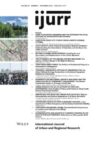In this article I draw on the embodied experience of driving into potholes and on bumpy roads in Hyderabad to show how pockmarked roads become a terrain on which political sensibilities are shaped. Drawing on ethnographic material collected over six years, I analyze how potholes shape driving dispositions in a city that is attempting to brand itself as ‘world class’. I show that far from being merely physical interruptions on the surface of the road, potholes engender political subjectivities in three ways: one, they generate, sustain and institutionalize narratives of state corruption; two, through their capacity to hurt, injure and even kill certain motoring bodies, potholes enable an experience of inequality in the register of pain and risk; and three, potholes spawn citizen engagement and claims-making. Through a discussion of these three processes, I consider how and why the banal pothole becomes an aperture through which to view the desires, discomforts and disappointments of urban life in India. Ultimately, I argue that driving is a key mode of experiencing urban inequality, and that road surfaces are generative of politics in and of the city.
‘Surfaces provoke our first sensations, evoke our initial reactions, and become the stuff of our comparisons, analogies, images, and representations.’
Joseph Amato (2013: 9)
